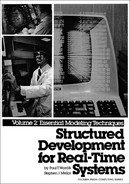Index
Alternative transitions, 53
Attributes, system, 25
Audit trail, 85
Behavioral model, 4, 6–7, 24–25, 41, 80, 82–84
Candidate features, 85
Communications link, 6–7, 17, 21
Context, 14
Context definition, 14, 16, 24, 27
Context reduction, 22–23
Context schema, 14, 17–19, 21–28, 30–31, 37, 41–42, 81–82, 90, 107, 124, 139
Continuous transformation, 33, 57
Control hierarchy, 66–67
Control transformation, 8–11, 47, 49, 57–58, 65, 71
Data dictionary, 100–101, 115–116, 131–132, 150–153
Data flow, 8, 31–32, 36, 46, 55, 63
Data schema, 25, 37–38, 41–45, 59–60, 62, 78
Data store, 8
Data transformation, 7–8, 11, 46–47, 50, 57–58, 71
Embedded systems, 4, 7, 12, 16–17, 22–23, 33, 37, 47, 55, 85
Entity-relationship diagram, 59, 141
Environmental model, 41, 80–81, 83–84
Environment-based modeling, 1, 3–4
Essential model, 1, 12, 14, 32, 62, 66, 70–71, 75, 77–78. 80–82, 86
Essential process grouping, 64–65
Essential system, 21
Event flow, 11, 36, 47–49, 55, 57
Event list, 36–39, 41, 46, 50–52, 62, 71, 81, 91, 108, 125, 140
Event modeling, active, 36–37
Event modeling, passive, 37–38
Event recognition, 33–35, 47–49, 57, 66
Event response, 48, 56, 58–59, 62, 73
Extraction, 75
Flat form, 62
Flow-direct event, 49
Functional decomposition, 1–3
Hierarchical form, 62
History data, 73
Implementation algorithms, 74
Implementation dependence, 17, 55, 72
Implementation independence, 14, 21, 48, 55, 71, 73
Implementation technology, 20–21, 78
Indirect recognition mechanism, 33, 46
Informal requirements model, 41–42
Interaction, 24–25
Interface technology, 19
Jackson System Design method, 8
Keyboard configuration, 6–7
Leveled context schema, 26–27
Loop, 51
Lower-level transformations, 62, 71
Mapping, 4
Minimum-complexity representation, 1, 7–11
Multiple context schema, 26, 28
Mutually exclusive event groups, 54
Narrative requirements, 80
Narrative specification document, 80, 85
Notation, context schema, 15
Notation, transformation schema, 14
Objects, perception/action space, 4–7, 19, 37, 53
Operations, 44
Outside-in modeling, 4
Packaging, flow, 26
Parallel components, 73
Parallelism, 72
Partitioning, 2, 63, 65–66, 71–74
Perception/action space, 4–6, 17, 24, 37, 46
Perception mechanism, 49
Preliminary data schema, 59
Preliminary transformation schema, 50, 92, 126, 142
Real-world associations, 44
Regions, 47–48
Retrieval transformations, 43
Sensor/actor technology, 18–19, 47
Sensors/actors, 6, 17, 19, 21, 37, 53, 78
Sequential components, 73
State transition diagram, 8–9, 11, 46–47, 50–54
Storage transformations, 43
Storage-data-driven systems, 44–45
Subject-matter-centered modeling, 1, 4, 6–7
Subject-matter specificity, 6, 17
System model, 38
System transformation, 39
System view, 21
Terminators, 14–15, 17, 22, 24, 26–27, 30, 36, 39, 46–47, 69, 80–81
Time-continuous data flow, 31–32, 49
Time-discrete data flow, 31–32, 46, 49, 55
Time-out mechanism, 39
Timing out, 57
Traceability, 81–85
Tracing event responses, 75, 78
Transformation products, 80
Transformation-driven system, 44–45
Transformation schema, 8, 24, 26, 42–50, 62–63
Transformation specifications, 102–103, 117–120, 133–135, 154–159
Transformation structure, 43
Transitory structure, 43
Transitory state, 55–56
Upper-level grouping, 62, 66, 69–70
User view, 21
Virtual device, 19
